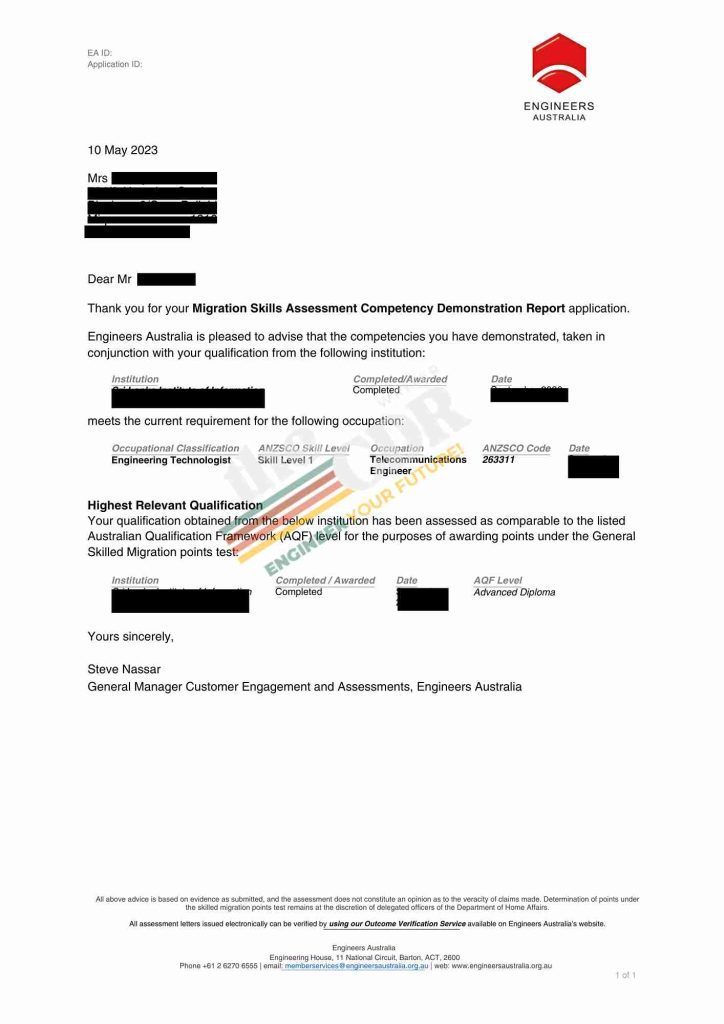Summary Statement for Transport Engineer (ANZSCO 233215)
Our expert CDR writers help you craft a well-structured summary statement, ensuring you present your competencies effectively for a successful skills assessment.

At A Glance
Here are four clear bullet points summarising what has been covered in the content:
- Overview of Transport Engineer (ANZSCO 233215): Role, qualifications, responsibilities, collaboration with stakeholders, and relevance to Australian skilled migration visas (189, 190, 491).
- Purpose of the Summary Statement: Explanation of how it maps career episode paragraphs to the 16 EA competency elements and must be written in clear, original English.
- Sample Summary Statement Provided: A professional example highlighting key skills such as transport planning, traffic modelling, data-driven analysis, and adherence to Australian standards.
- Emphasis on Reliability and Assessment Success: Assurance that a well-crafted Summary Statement increases the chances of obtaining a positive Skilled Assessment from Engineers Australia.
A Brief on Transport Engineer (ANZSCO 233215)
A Transport Engineer (ANZSCO 233215) in Australia plays a vital role in planning, designing, and managing transport systems to ensure safe, efficient, and sustainable movement of people and goods. These professionals typically hold a bachelor’s degree in civil, transport, or traffic engineering, supported by industry experience and, ideally, professional accreditation. Their responsibilities include designing and upgrading key transport infrastructure such as roads, highways, intersections, and public transit networks
They work closely with urban planners, architects, contractors, and government authorities to deliver integrated transport solutions. As a recognised skilled occupation in Australia, Transport Engineers are eligible for visas such as subclass 189, 190, and 491. Therefore, making them highly valued in the migration system.
Transport Engineer Summary Statement Sample (Career episode to summary statement
A summary statement for a Transport Engineer is presented in a tabular format. It included three career episodes and cross-references specific paragraph numbers to show how you meet each of the required 16 competency elements. The content of the sample is as follows:

Curriculum Vitae
Resume prepared using a professional engineering template.
Continuing Professional Development Sample
CPD sample explaining the author’s transport engineering knowledge and recent learning — approximately 1000 words.
Transport Engineer Career Episode Report Sample – 1
"Traffic Impact Assessment and Signal Optimisation for a Major Urban Intersection" – 1800 words
Transport Engineer Career Episode Report Sample – 2
"Geometric Design and Safety Upgrade of a High-Volume Highway Section" – 1700 words
Transport Engineer Career Episode Report Sample – 3
"Design and Implementation of a Sustainable Pavement Rehabilitation Strategy" – 2000 words
Transport Engineer Summary Statement Sample
Cross-referencing paragraphs from career episodes with EA competency elements.
Transport Engineer Summary Statement Sample [With Format]
These are the Career Episode (CE) references used based on the specific project list:
- CE1: Traffic Impact Assessment and Signal Optimisation for a Major Urban Intersection
- CE2: Geometric Design and Safety Upgrade of a High-Volume Highway Section
- CE3: Design and Implementation of a Sustainable Pavement Rehabilitation Strategy
Competency Element | A brief summary of how you have applied the element | Paragraph Number |
PE1 KNOWLEDGE AND SKILL BASE | ||
PE1.1 Comprehends and applies knowledge of science and engineering fundamentals. | I applied transport engineering principles including traffic flow theory, geometric design physics, and pavement mechanics. In CE1, I utilized gap acceptance theory and queuing analysis. In CE2, I applied kinematics to calculate stopping sight distances and superelevation. In CE3, I used material science principles to determine the fatigue life of the pavement structure. | CE1.2.1, CE1.3.1, CE2.2.1, CE2.3.2, CE3.2.1 |
PE1.2 Demonstrates a wide knowledge of the practice area. | I demonstrated deep knowledge of relevant standards. In CE1, I used SIDRA Intersection software and Austroads Guides. In CE2, I applied AASHTO standards for horizontal and vertical alignment using Civil 3D. In CE3, I utilized local municipal specifications for asphalt mix designs and layer thickness. | CE1.3.2, CE1.4.1, CE2.3.1, CE3.2.2 |
PE1.3 Engages in the creative, innovative and pro-active development of engineering practices. | I developed innovative solutions to address site constraints. In CE1, I designed a unique actuated signal phasing scheme to handle peak hour fluctuations. In CE3, I proactively incorporated Recycled Asphalt Pavement (RAP) into the mix design to improve sustainability without compromising structural integrity. | CE1.4.2, CE2.4.3, CE3.3.1 |
PE1.4 Applies advanced technical knowledge to solve engineering problems. | I resolved complex issues using advanced calculations. In CE1, I modeled complex saturation flows to resolve a bottleneck. In CE2, I calculated earthwork cut-and-fill volumes to balance the vertical profile. In CE3, I analyzed the modulus of elasticity to solve subgrade stability issues. | CE1.3.3, CE1.4.4, CE2.4.1, CE3.3.2 |
PE1.5 Demonstrates an understanding of the scope, principles, norms, accountabilities and bounds of contemporary engineering practice. | I adhered to engineering ethics and safety standards. In CE2, I applied the “Safe System” approach to minimize crash severity. In CE3, I ensured the rehabilitation strategy complied with environmental regulations regarding construction waste disposal. | CE1.1.1, CE1.5.1, CE2.1.1, CE2.5.1, CE3.1.2 |
PE1.6 Demonstrates an understanding of the social, cultural, environmental and commercial responsibilities of a professional engineer. | I considered the broader impact of my work. In CE1, I improved pedestrian crossing facilities to enhance community safety. In CE2, I conducted a cost-benefit analysis for the safety barriers. In CE3, I focused on extending the pavement lifecycle to provide economic value to the client. | CE1.5.2, CE2.5.2, CE2.5.3, CE3.4.1 |
A Summary Statement must be written in clear English and entirely in your own words, showcasing the engineering competencies demonstrated throughout your professional experience. The Summary Statement maps specific elements of your work to the competency units required by Engineers Australia.
The Summary Statement should highlight your engineering knowledge and techniques, your capacity to solve problems and introduce innovative solutions, and your skills in design, development, and project management.
Transport Engineer summary statement Sample
“I am a qualified Transport Engineer with experience in planning, designing, and optimising road, traffic, and public transport systems. My work focuses on improving network efficiency, safety, and sustainability through data-driven analysis and innovative engineering solutions. I have contributed to traffic modelling, demand forecasting, signal optimisation, and multimodal transport planning for urban and regional projects. I collaborate effectively with multidisciplinary teams, apply relevant Australian standards, and consistently deliver solutions that enhance mobility and support long-term infrastructure goals”.
Transport Engineer Summary Statement Sample
“I am a qualified Transport Engineer with experience in planning, designing, and optimising road, traffic, and public transport systems. My work focuses on improving network efficiency, safety, and sustainability through data-driven analysis and innovative engineering solutions. I have contributed to traffic modelling, demand forecasting, signal optimisation, and multimodal transport planning for urban and regional projects. I collaborate effectively with multidisciplinary teams, apply relevant Australian standards, and consistently deliver solutions that enhance mobility and support long-term infrastructure goals.”
Proof of Our Reliability: Positive Skill Assessment
Every part of the Summary Statement is crafted with one goal in mind: securing a positive outcome letter from Engineers Australia, your essential gateway to beginning a successful skilled migration journey.
Check Out More Summary Statement Samples
Why Trust Us?
All our samples are regularly updated and fully aligned with the latest EA and ACS guidelines to ensure accuracy and relevance.

Latest Version
All our samples are up to date and comply with the most recent EA and ACS guidelines.

Original Content
Every sample is uniquely crafted and written from scratch by our expert report writers, guaranteeing authenticity and originality.

Positive Results
We consistently receive excellent feedback from clients thanks to our high-quality, results-driven samples.

Format and Structure
All samples follow the official formatting and structuring requirements set by the respective authorities, ensuring full compliance.
GET FREE CDR CONSULTATION
Pricing Guide for CDR Writing
More than 7845 People Signed Up for our Writing Guidance! Are You NEXT?
I received great advice from CER Writers during my CDR submission. They addressed all of my inquiries and produced an excellent career episode report Engineers Australia template that complied with all specifications. My skills assessment was accepted on my first attempt and received positive outcomes.




I am very thankful and happy with TheCDRWriter; their personalised approach and expert advice were flawless. I received positive outcomes from EA on the first attempt.